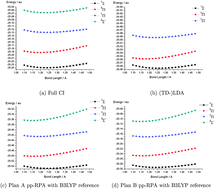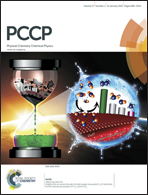Analytic gradients, geometry optimization and excited state potential energy surfaces from the particle-particle random phase approximation†
Abstract
The energy gradient for electronic excited states is of immense interest not only for spectroscopy but also for the theoretical study of photochemical reactions. We present the analytic excited state energy gradient of the particle-particle random phase approximation (pp-RPA). The analytic gradient formula is developed from an approach similar to that of time-dependent density-functional theory (TDDFT). The formula is verified for both the Hartree–Fock and (Generalized) Kohn–Sham reference states via comparison with finite difference results. The excited state potential energy surfaces and optimized geometries of some small molecules are investigated, yielding results of similar or better quality compared to adiabatic TDDFT. The singlet-to-triplet instability in TDDFT resulting in underestimated energies of the lowest triplet states is eliminated by pp-RPA. Charge transfer excitations and double excitations, which are challenging for most adiabatic TDDFT methods, can be reasonably well captured by pp-RPA. Within this framework, ground state potential energy surfaces of stretched single bonds can also be described well.


 Please wait while we load your content...
Please wait while we load your content...